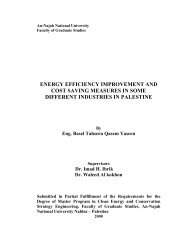THE GENUS PYTHIUM - An-Najah National University
THE GENUS PYTHIUM - An-Najah National University
THE GENUS PYTHIUM - An-Najah National University
Create successful ePaper yourself
Turn your PDF publications into a flip-book with our unique Google optimized e-Paper software.
<strong>PYTHIUM</strong> ROSTRA TUM Butler, Mem. Dep. Agric. bot. Ser.<br />
Figs. 101-103<br />
1:84 )1907)<br />
COLONY MORPHOLOGY: Colonies on CMA showing a chrysanthemum<br />
pattern; no development of aerial mycelium. MYCELIUM: Main hyphae 3-6<br />
(av. 3.6) .um wide. SPORANGIA: Terminal or intercalary, globose and<br />
subglobose, 15-35 (av. 23.1) .nm diam, zoospores produced at 10_20° C.<br />
OOGONIA: Mostly intercalary, occasionally terminal, subglobose, smooth, 14-<br />
25 (av. 18.7± 0.9-95% c.!.)..um diam, often in chains. AN<strong>THE</strong>RIDIA: 1-2 per<br />
oogonium, monocIinous, often sessile originating immediately below oogonium<br />
base, or hypogynous. OOSPORES: Plerotic (oospore volume/ oogonium volum-<br />
0.75),13-23 (av. 17.0± 0-7-95% c.l.)..um diam, wall 1-2 (av. 1.3± 0.1-95% C.I.)<br />
urn thick, ooplast 6-11 (av. 8.8) ..urn diam. TEMPERATURE-GROWTH<br />
RELATIONSHIPS: Minimum 5' C, optimum 15-20· C, maximum 30C. Daily<br />
growth rate on CMA at 25°C 5.6mm.<br />
MATERIAL EXAMINED: ex Zea mays, Nassareyeh (FCCAU 119.25),<br />
Citrus sinensis (L) Osbeck, Nablus (FCCAU 119.26); ex soil, Jenin (FCCAU<br />
119.10), and many other isolates.<br />
OCCURRENCE: Frequently isolated from diseased roots, and also<br />
constantly present in soil (found in 85% of the soils sampled). This species was<br />
also isolated from soil in the Lebanon (Ahrens, 1971) and Iraq (AI-Doory et al.<br />
1959).<br />
<strong>PYTHIUM</strong> SALPINGOPHORUM Drechsler, J. Wash. A cad. Sci. 20:507<br />
(1930). Figs 109-114.<br />
COLONY MORPHOLOGY: Colonies on CMA showing no special pattern;<br />
no development of aerial mycelium. MYCELIUM: Main hyphae 3-6 (av. 3.6)<br />
J.Im wide, occasionally developing elongated or ovate, often catenulate<br />
appressoria present. SPORANGIA: Mostly terminal, occasionally intercalary,<br />
sometimes catenulate, occasionally proliferating, subglobose to globose, 17-28<br />
(av. 22.5) J.Im diam, zoospores produced at 10-26 C, emmision tube usually<br />
formed near a septum. OOGONIA: Mostly intercallary, frequently in chains of<br />
52





